Pentium 4 DOS Gaming
Despite its flaws, the Pentium 4 can still be a great way to get into high performance DOS gaming.

DOS gaming is a particularly interesting era of computer gaming because hardware and operating systems were rapidly evolving around that time. The advent of VGA cards and the notorious Sound Blaster meant that home computer gaming could gain the ability to catch up to their popular console counterparts of the day.
This is a work in progress and will be updated as I get new info. Please let me know of any inaccuracies so I can fix them promptly. Thank you!
Legacy
I wouldn't consider any assumed motivations in this section to be factual - this is what I have assembled as collected from the experiences of others, forum posts, newsgroups, and so on.
Home IBM PC gaming wasn't seriously considered by many but the most dedicated enthusiasts. The likes of Commodore's C64 and Amiga machines, home consoles such as the NES and Master System, and the price point and market these computers were marketed to certainly didn't help the popularity. These were business machines that had business software and did business things that could also play a few games.
As new graphics and sound devices were unveiled for the IBM PC, publishers and game developers stepped in to take supreme advantage of the new raw power offered by hardware. Newer, faster buses were developed to facilitate the greater needs of this new hardware. It all started with the 8-bit ISA bus in the IBM PC AT. Later, we got 16-bit ISA, PCI and AGP. It was wild in the late 80's through the early 2000's: standards were being proposed, implemented and thrown away at a record pace.
DOS gaming was generally made possible by a number of low level tricks. A game like Doom from 1993 can run as fast as it does thanks to how it carefully uses coincidences between the chosen render method and video memory layout. Sound cards could play audio on the fly using DMA so the game didn't have to worry about repetitive tight timing - just tell the sound card where the data is and let it rip. These tricks only worked because of the completely unrestricted access games had to the hardware.
When Windows 95 rolled around (and later 98), DOS gaming was in trouble. Microsoft was pushing DirectX and trying to get manufacturers on board for support. An operating system such as Windows can't allow applications free reign to the hardware anymore. Meanwhile, Intel was trying to deprecate ISA on their chipsets in favor of PCI, and AGP was attempting to dethrone PCI graphics. Both of these things eventually succeeded, but caused many headaches for customers as far as compatibility in the meantime.
Intel's 440BX chipset was the last chipset that many motherboard manufacturers made significant effort to support ISA on. It was an exceptional chipset and a consumer favorite, even after Intel attempted to introduce their 810 chipset later on (which tried and failed at also pushing the far more expensive RAMBUS technology on consumers.) Many consumers stuck with 440BX or went with chipsets from other manufacturers. VIA and AMD chipsets sold well to bridge the gap.
Intel later released the 845 chipset which seemed like a home run compared to their previous efforts. Motherboards with this chipset used DDR memory, which became cheaper and more readily available when these boards proliferated throughout the market. This chipset also helped to usher in the age of Pentium 4.
DOS gaming was virtually extinct by the time this 845 chipset came around. It was already 2002, and Windows XP was the new bubbly hotness. Around this time, mainstream use of the old 9X-based versions of Windows was declining fast. Unfortunately, that also meant that the compatibility with popular DOS games was also on the decline. Virtualization was paramount to keeping as many of these titles playable as possible, but some of them worked too closely to the hardware to be useful.
As the chipsets were maturing, support for important low level functions began to disappear. After early Pentium 4 boards, it's nearly impossible to find something that is compatible with older sound cards. PCI Express killed off AGP graphics for good after Intel's 9xx chipsets became popular.
The Case Against Pentium 4
There are a few reasons why Pentium 4 is not ideal for DOS gaming.
The Pentium 4, while it sold well, is considered now to be somewhat of a technological dead end. Intel gambled on the idea of a longer pipeline and pushing processor clock speed through the roof. As the amount of power pushed through these chips increases, though, the heat generated increases exponentially. These chips get unreasonably hot when they are pushed over 3 gHz. It's not practical to push clock speeds higher anymore. Intel had to learn that the hard way.
Additionally, the Pentium 4's longer pipeline means inconsistent branching in the code is a far more expensive operation. Since most DOS games were written using compilers that targeted older architectures (80386 or even 8086), many of the features of the processor that made it faster on modern computers will never be used. The user gets none of the benefits of a newer processor architecture while still being burdened by the Pentium 4's greatest performance issue. Branch prediction helps mitigate this issue a little, but not much. Today's processors are exceptionally better at it.
Despite its flaws, however, the Pentium 4 can still be a great way to get into high performance DOS gaming. They're plentiul and cheap on eBay - even the faster ones. Building a system around a 440BX chipset tends to be a lot more expensive. Motherboard/CPU compatibility, when compared to earlier architectures, was far more difficult to navigate. BIOS features on Pentium 4 boards can still have important settings that are relevant to DOS gaming as well, such as control over the cache and disabling onboard devices to free up resources.
The whole thing's easier to just get working.
Things to Know
There's a few things to keep in mind while doing a Pentium 4 build.
Socket 478
The Pentium 4 was released for a couple different socket types. Boards with Socket 478 will typically be the only ones with the features that are required for a complete setup.
Willamette, Northwood, Prescott CPUs
Pentium 4 CPUs will come in one of three different versions.
Willamette is the first one and goes up to 400 mHz FSB. These are some of the lowest power Pentium 4 chips. Northwood is the most versatile one and is the ideal choice because it can cover any three of the available FSB speeds and is also generally compatible with pretty much any board. Prescott processors are the ones to stay away from since they're often too new for many boards and are also known for their intense heat generation.
To most accurately and rapidly identify a CPU, check out CPU World.
Motherboard FSB support
Pentium 4 chips for Socket 478 come in three different FSB flavors: 400, 533, and 800. Chips rated lower are almost always guaranteed to work in motherboards that support a higher rating. Getting a 400 will always be safe, and the maximum clock speed that can reasonably be found for these chips is 2.8 gHz. However, in order to squeeze out the best performance, get the highest FSB supported by the motherboard.
DDR memory
Memory on the Pentium 4 boards we're looking for are all DDR SDRAM. It may also be referred to as DDR1 to differentiate it from the later types. None of the different types of DDR are compatible with each other - DDR2 cannot be used as DDR3 or vice versa. Also, most boards in this era will support a maximum of 2GB, but strange compatibility issues start happening beyond 512MB. Two sticks of 256MB DDR should do the trick. It's extremely rare one would need more than 32MB for a DOS game, but 64MB is a safe amount. 512MB is way overkill, but it's fun.
DDR modules will also have an FSB rating on them. Their performance will be limited by the FSB on the CPU, and are best matched at half. For example, if the CPU is 533mHz, the RAM should be at least 266mHz. Lower will be slower, higher will offer zero benefit. The RAM cannot transfer data to and from the CPU faster than the CPU can request it.
There will also be latency numbers. For example, my current sticks are 2-2-2-5. The lower these numbers, the better. Although, the most significant number is the first one, or CAS latency. It's a fancy way of saying "the delay between the request for a particular piece of memory and when the request can be fulfilled". Lower numbers indicate they will likely need more power to operate.
Chipsets: 845, 865, 875
There are many variants of the 845 chipset. It's not common to find the 865 or 875 chipsets outside of enthusiast or industrial motherboards (or a very couple special OEM boards.) The difference between these is rather minimal, although the 865 and 875 will allow the use of 800 mHz FSB.
The 845 variants usually have the ICH2 or ICH4 south bridge, and the 865/875 will typically have ICH5. These are the last IO chips that can support the signalling that ISA sound cards require.
Two chipsets to be mindful of are the 845GL and 845GV. Both of these lack AGP, so a PCI video card is required if the onboard video isn't used (and onboard shouldn't be used for reasons explained later.) The GL version is the weakest of them all and has a maximum 400mHz FSB according to Intel's website.
ISA Bridges
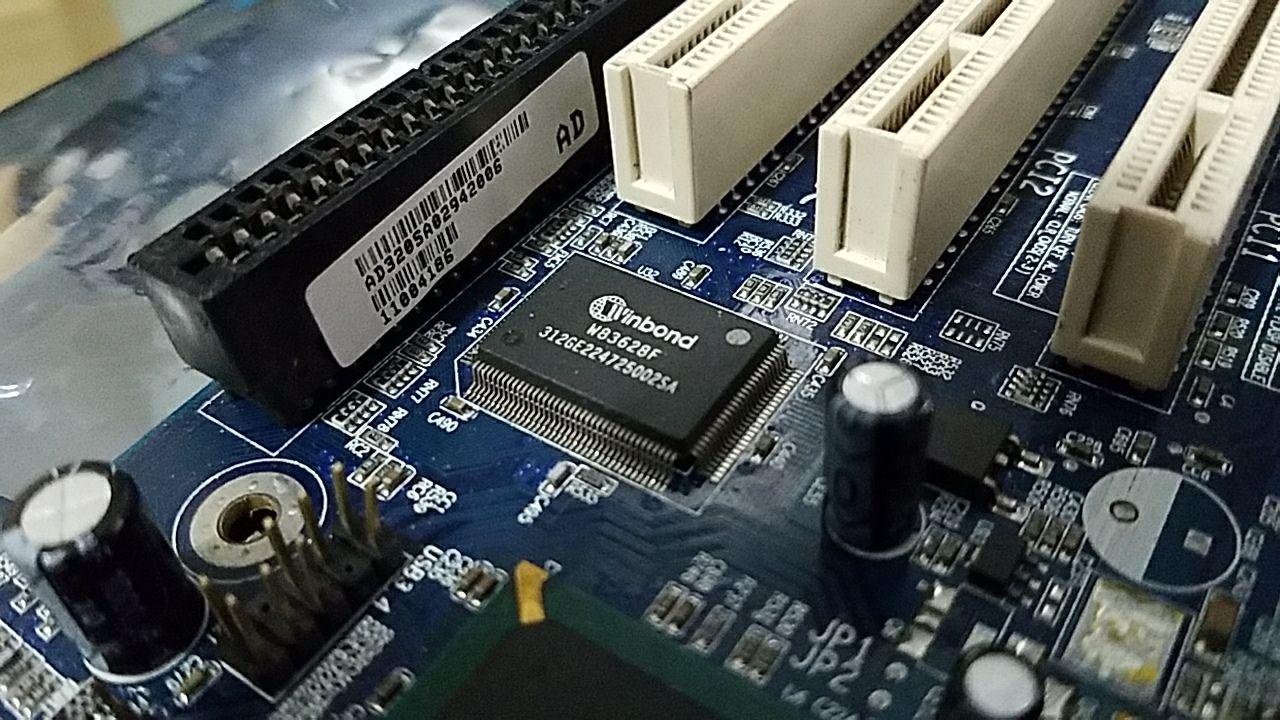
Later boards make use of ISA bridge chips. Switching to different boards that use the same PCI/ISA bridge offers no seemingly different results as far as ISA compatibility goes. It doesn't appear that there are any other PCI/ISA bridges in use by motherboard manufacturers, but if there is one not covered here, I'm very interested to know about it.
Intel ICH5 is the final southbridge that will provide the signals needed by these bridge chips. Despite this, these bridge chips can be found on motherboards with even newer ICH chips, but will not have functioning DMA, which is required for proper sound card operation.
| Model | Description | Notes |
|---|---|---|
| ITE IT8888F/G | PCI-ISA bridge | Reported to have great compatibility by multiple sources. These are a bit less common and typically only found on industrial boards. |
| Winbond W83626F | LPC-ISA bridge | No reports of these being compatible. See below. |
| Winbond W83628F | PCI-ISA bridge | Confirmed working in multiple boards, but not with all ISA sound cards. Likely the most common bridge. |
There is a Vogons Forums topic about the difficulties of getting the W83626F bridge working with ISA sound cards. It could very well be the way that the bridge is wired to the rest of the board. I have not yet found another board with this bridge.
CPUs
I have not received a single dead Pentium 4. Not sure if I should feel lucky about that. Pentium 4s are obnoxiously cheap on eBay. Sometimes sellers just throw them in for free.
Northwood 2.8gHz, 400mHz FSB, 512k cache (SL7EY)
More info at CPU-World.
This is probably the fastest 400mHz FSB processor I could find to fit any of my Pentium 4 boards. They aren't particularly expensive either. If it's unknown whether or not a motherboard supports a 533mHz FSB processor, picking one of these up isn't a bad choice.
Northwood 3.06gHz, 533mHz FSB, 512k cache (SL6PG)
More info at CPU-World.
There's a number of different model numbers for these particular specs. It's the fastest 533mHz FSB processor I could find. These aren't too expensive to get. However, I could not get this working in the HT845ISA board. I was forced to switch to 400 mHz FSB using the board jumper, which hit me with a roughly 25% clock speed drop.
Motherboards
Many motherboards exist that will work for a DOS Pentium 4 machine. They vary in form and features.
HT845ISA/1 (AMI-I845GV-ISA)
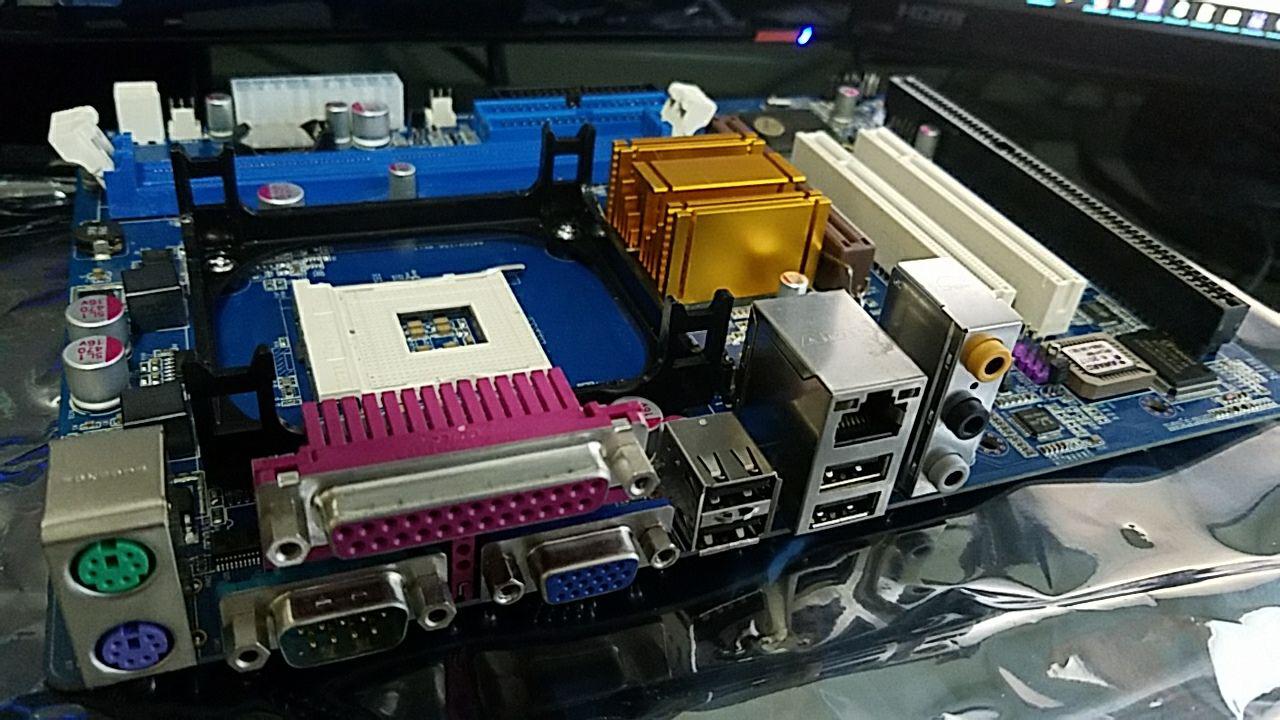
- Form: Micro ATX, with caveats
- Socket: mPGA478B
- South Bridge: ICH4
- Video: Onboard + AGP (1.5v only)
- Audio: Realtek ALC653, HD Audio, 4-pin CD input
- LAN: Realtek RTL8100C
- IO: Winbond W83627HG-AW, Winbond W83628F
This motherboard can be purchased new from AliExpress. I find this to be particularly impressive. I even got a BIOS chip that is copyright 2017. That's wild. I don't anticipate the contents of the BIOS are any different from years ago, but that they're still manufacturing these things is pretty awesome.
Don't be put off by the "GV" name, I was able to get the AGP slot working on these boards just fine. I suspect they are AGP 4x.
The FSB is selectable with a jumper between 400/533/auto. I tried using a 3.06 gHz 533 FSB Northwood, but the machine refused to boot with it until I selected 400. A 2.8 gHz 400 FSB Northwood worked just fine. I suspect a slightly slower 533 FSB Northwood may work.
Be careful ancitipating a Micro ATX board! I got burned by the fact that this board is ever so slightly larger than my other Micro ATX boards, and it would not fit properly in my Micro ATX case. I purchased a larger bench case to fit this board.
There exists the HT845ISA/3 variant which is just the same board with two extra ISA slots.
QDI PlataniX 7LI/C-AL (P7LI/C-AL)
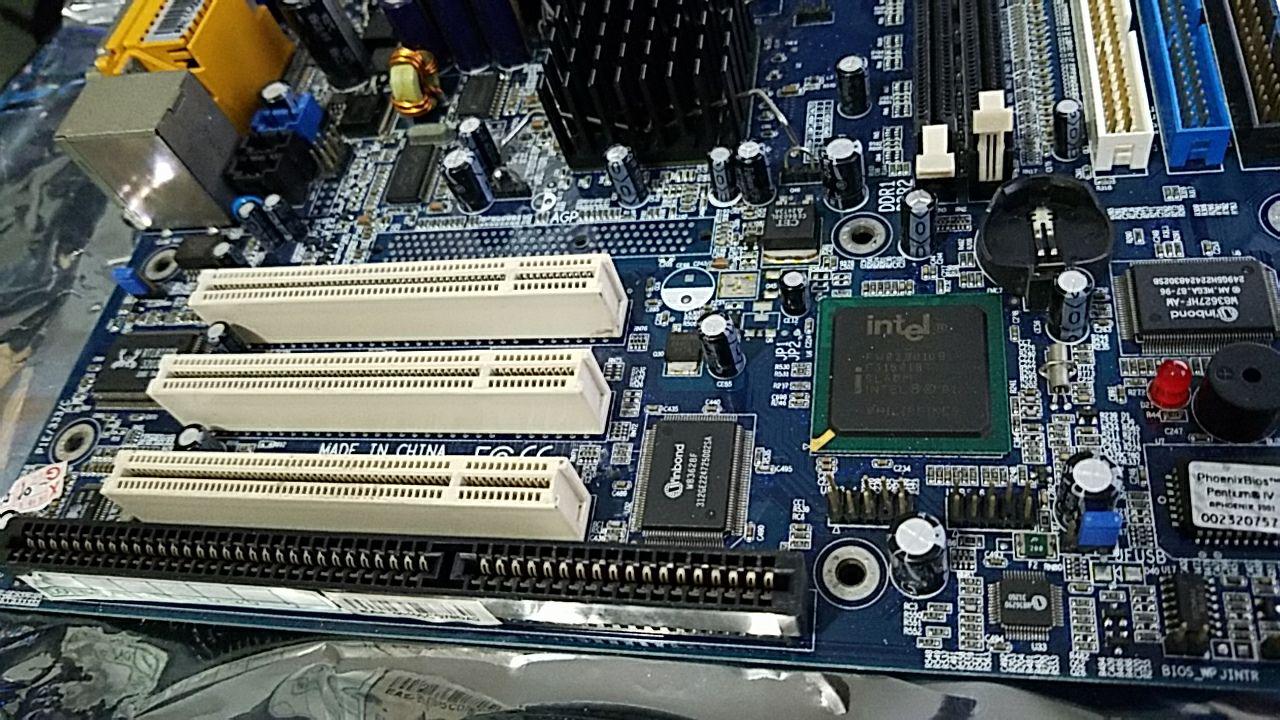
- Form: Micro ATX
- Socket: mPGA478B
- South Bridge: ICH2
- Video: Onboard
- Audio: Realtek ALC201A, two 4-pin CD inputs, modem input
- LAN: Realtek RTL8100C
- IO: Winbond W83627HF-AW, Winbond W83628F
This motherboard outputs a Chinese Lenovo screen on boot. These aren't particularly difficult to find used. QDI manufactured many Pentium 4 boards under the PlatiniX name. The PlatiniX 7 line is Micro ATX and does not have AGP. A PCI video card is required if not using the onboard video.
The variant without the "C" has a PC/PCI header on it. I suggest going with that one for the best variety of audio device interfaces.
Bonus: Deciphering PlatiniX Models
If we split up the name, we get "P7L" (PlatiniX 7L), "I" (has ISA support), "/C" (variant C), "-AL" (onboard audio and lan). This pattern works for all other motherboards in the PlatiniX series. A higher number in front doesn't mean a better board; this is used to differentiate integrated features and form factor. The 8E/333 and 2E/333 are the latest boards from 2003, and these support DDR333 and 533mHz FSB. Each of these also has the "I" option for an ISA slot.
Sound Cards
The most difficult part about building a Pentium 4 system for DOS is finding a sound card that won't glitch out like crazy. DMA timing is a serious issue on many modern boards when it comes to this. I suspect it has a lot to do with the PCI/ISA bridge chips doing the absolute bare minimum to make things work.
PnP in DOS is ironically difficult to configure, but Creative's software is typically the least hassle. Configuration of audio devices is typically more involved than video devices.
Aztech MMSN824
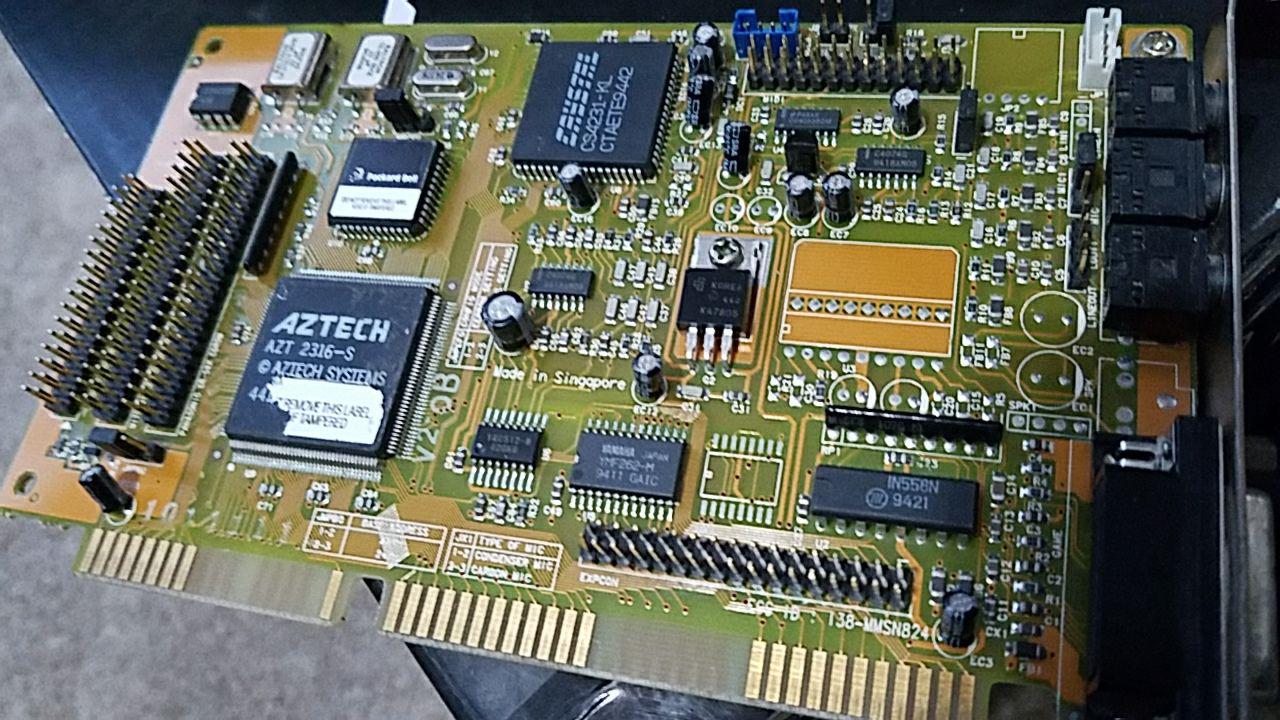
This is probably the only sound card that does everything I need it to without glitches. Well, mostly. The sound output itself is not that great on this card. But it actually plays back samples without skipping, and has a working Waveblaster header and DSP which doesn't cause hanging notes like the infamous Sound Blaster 16.
Finding the right drive when it comes to Aztech cards is the biggest pain ever. I recommend the Voyager drivers from Vogons. These worked great for me. I use hwset to configure the device and volset to configure the mixer in my autoexec, and it doesn't chew up any memory after setup.
Aztech MMSN853
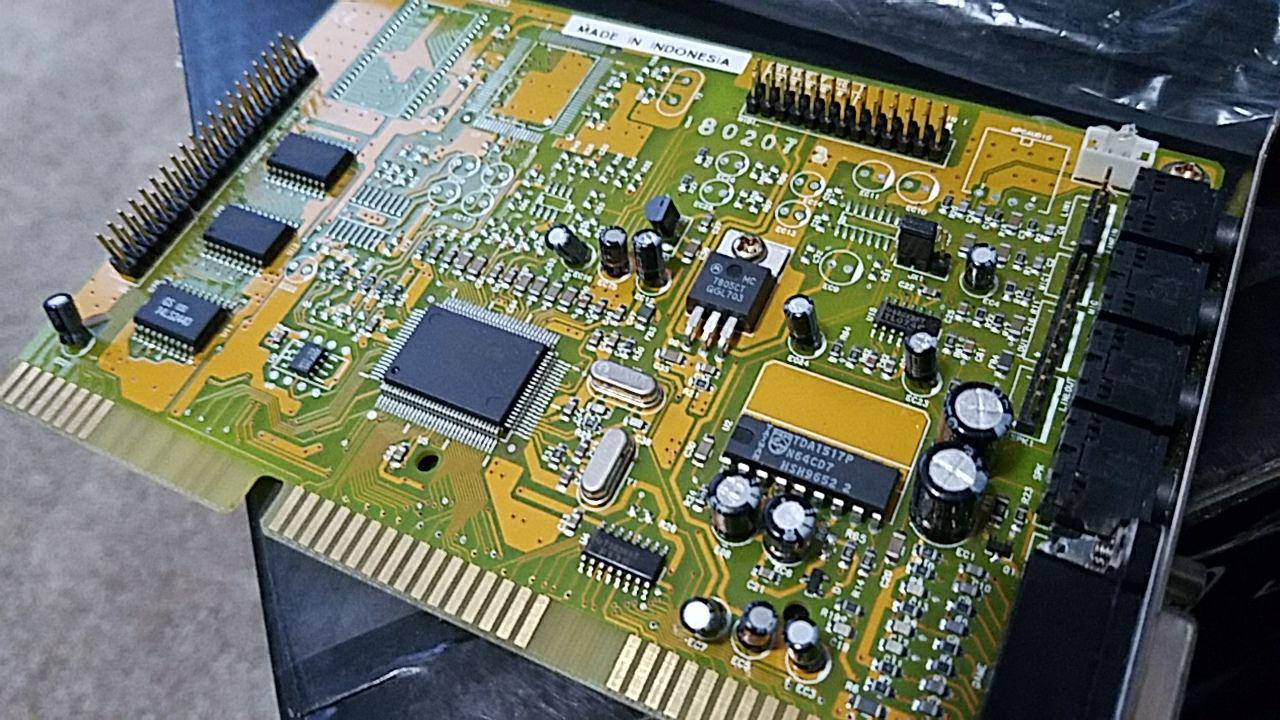
Don't bother with Aztech cards based on AZT2320. These are PnP and I simply cannot figure out how to get it working with any drivers whatsoever. Not worth the time. I also tried the MMSN855 with the same results.
Creative Sound Blaster Pro 2 (CT1600)
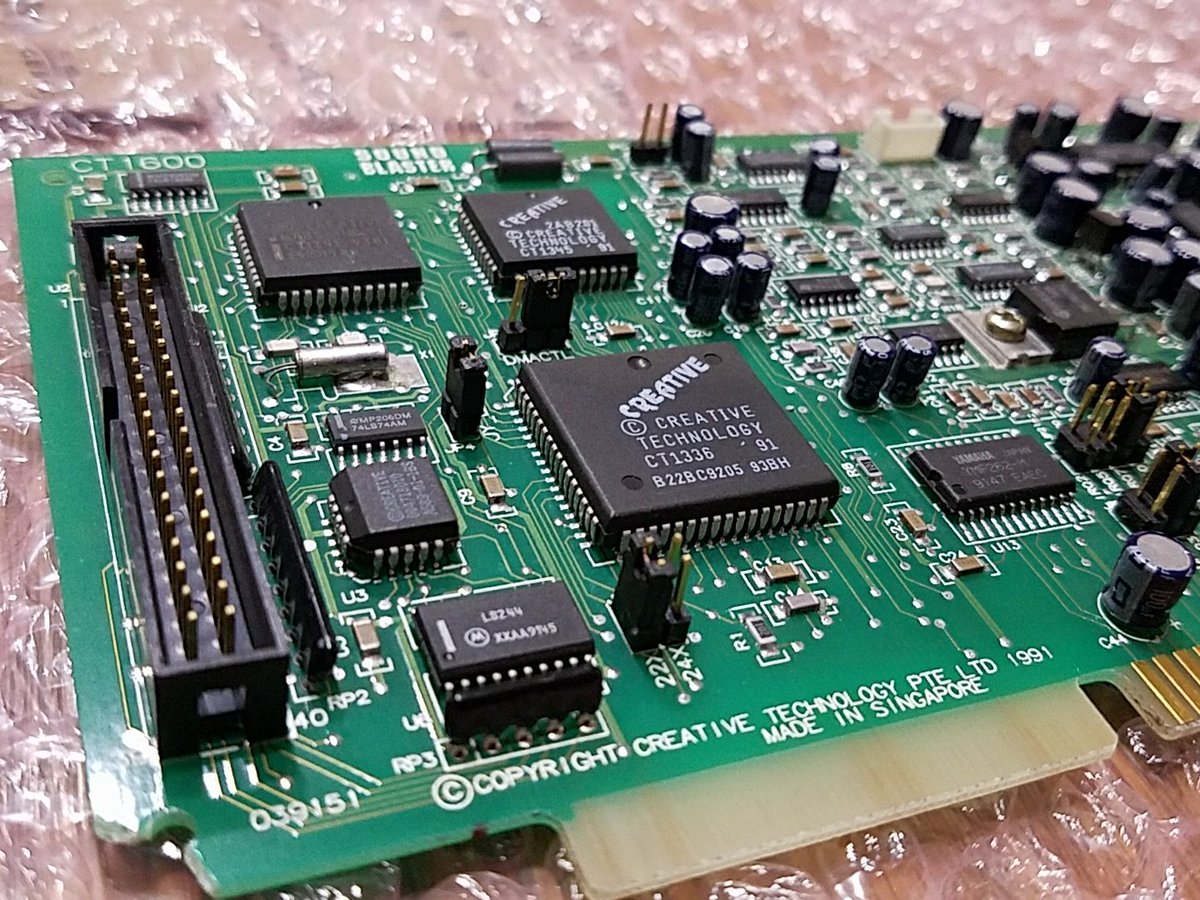
I was very excited to receive this card for testing. Unfortunately, the Sound Blaster Pro 2 does not work very well with either board. DMA compatibility issues cripple this card's performance. Digital audio playback skips 4 or 5 times per second.
I set the IRQs and DMAs via the jumpers on the board, configured these in the BIOS to "Legacy ISA", and it was immediately detected with no conflicts.
Creative Sound Blaster 16 (CT2890)
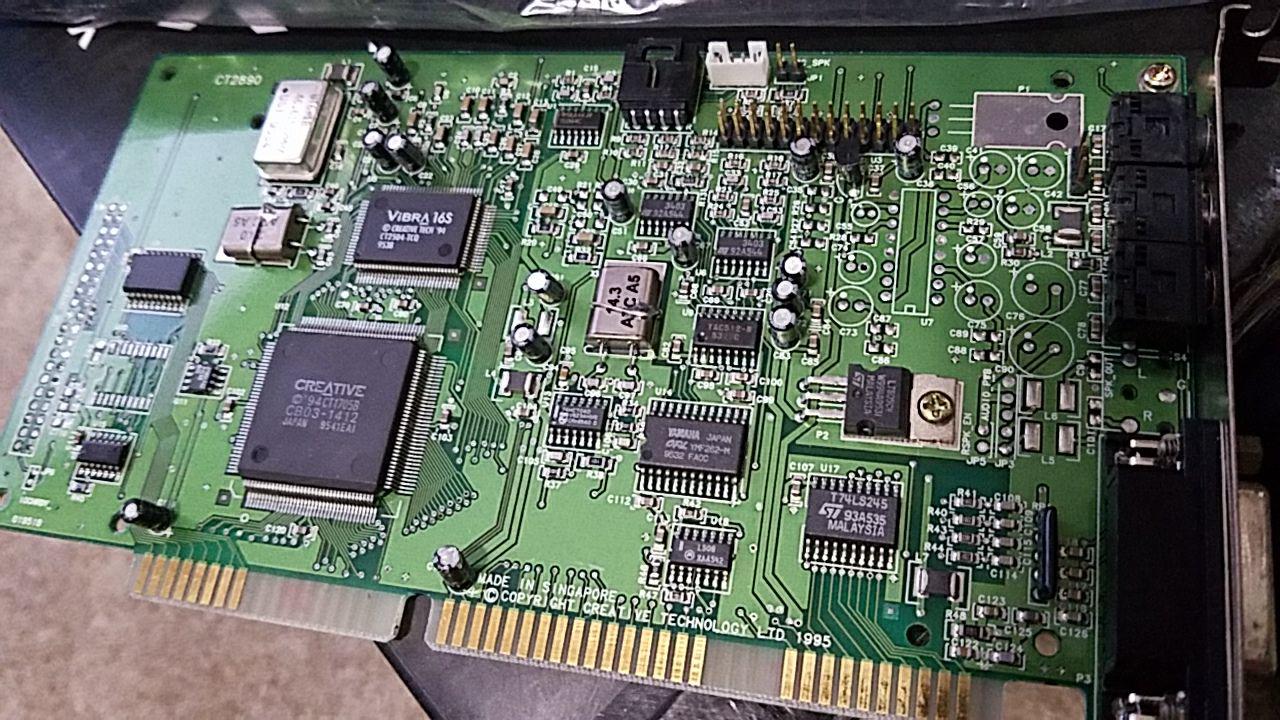
This card works and sounds great. It seems that anything at least as new as a Sound Blaster 16 should work with either of the above mentioned boards. If there's no need for the Waveblaster header, this should be a fine choice. Using the Waveblaster header and digital audio at the same time results in the "hanging note bug", which is very obvious and annoying when it happens.
I suggest getting the equivalent model without PnP, the CT2800. Others on the Vogons forums have mentioned that this card is noisy, but I am not experiencing the same result after turning down the mixer for all input sources.
For PnP models, be sure to run ctcm on startup in autoexec, and also run mixerset /P. This will configure the card's IRQ and DMA, and mixer settings respectively.
Creative Sound Blaster 32 (CT3600)
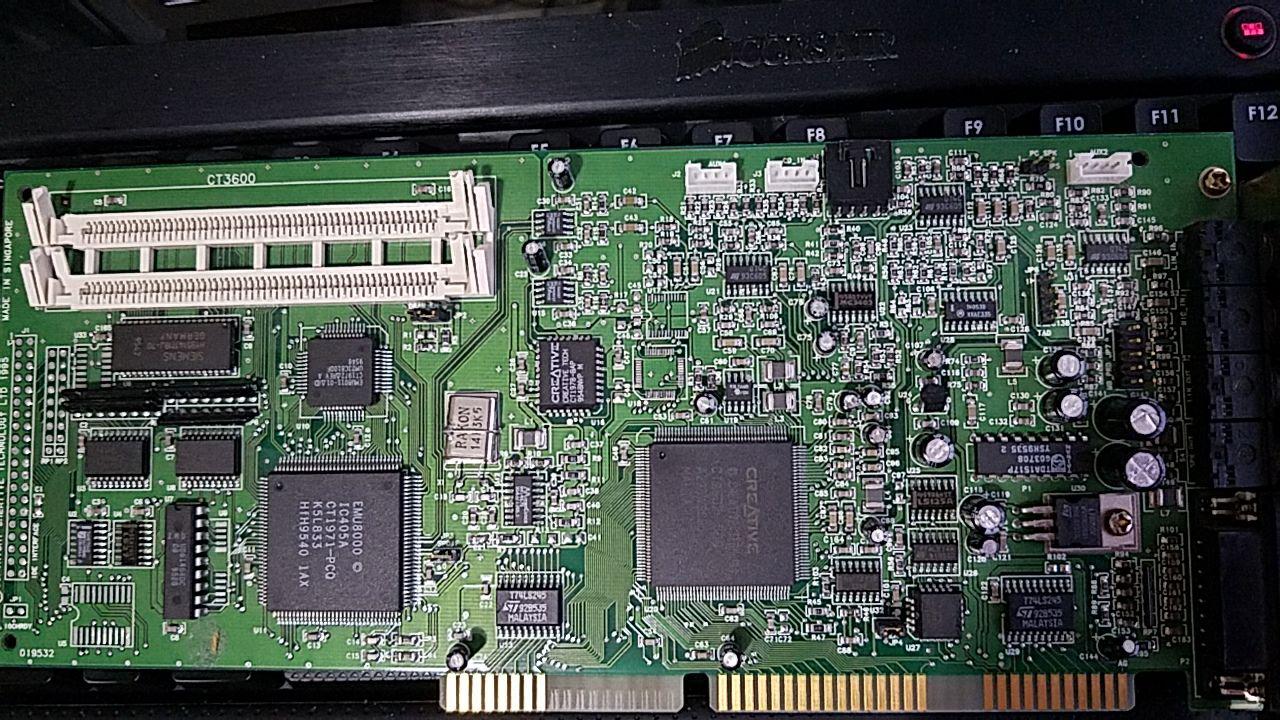
This card worked perfectly with all the programs I tested it with. I suspect other Sound Blaster (AWE)32 cards should work fine.
The steps for getting this working were precisely the same as the Sound Blaster 16 above. These are both PnP cards and are thankfully just as easy to configure. Probably the least hassle of any PnP device configuration, honestly.
MediaVision Pro Audio Spectrum 16 Basic (PAS16LL)

Even if it did work, I would recommend finding alternatives. I snagged this card for a great deal, but they're often expensive. This card has a problem with playing digital audio back at the wrong frequency in the setup program - it's far too high pitched - and I couldn't get the card to work at all in some programs. It would behave as if IRQ wasn't working.
The card can be detected properly in Impulse Tracker, but it seemingly cannot produce any sound.
Turtle Beach Tropez II (AU8830A2)
This card doesn't require protected mode in order to operate, but it still requires a 20k TSR. It's probably the only PCI card I've tested so far that could produce digital audio without having EMM386 loaded.
That said, it wasn't without issues. In Jill of the Jungle, when digital sounds were to be played, they wouldn't stop playing. The whole sound would loop over and over again. That got annoying really quickly. Zone 66 didn't find a Sound Blaster, but it did find the "Adlib". The OPL3 clone in this is really not great at all.
In order to get this card initialized, I needed a software package that contains AU30DOS, which is the TSR that should be loaded when the machine boots. It required me to have a file called AU30DOS.INI placed in the folder wherever the WINBOOTDIR environment variable was set. I just set that variable to the same folder as the driver and put the INI file there.
Yamaha Audician 32 Plus (LWHA151A00, A151-A00)
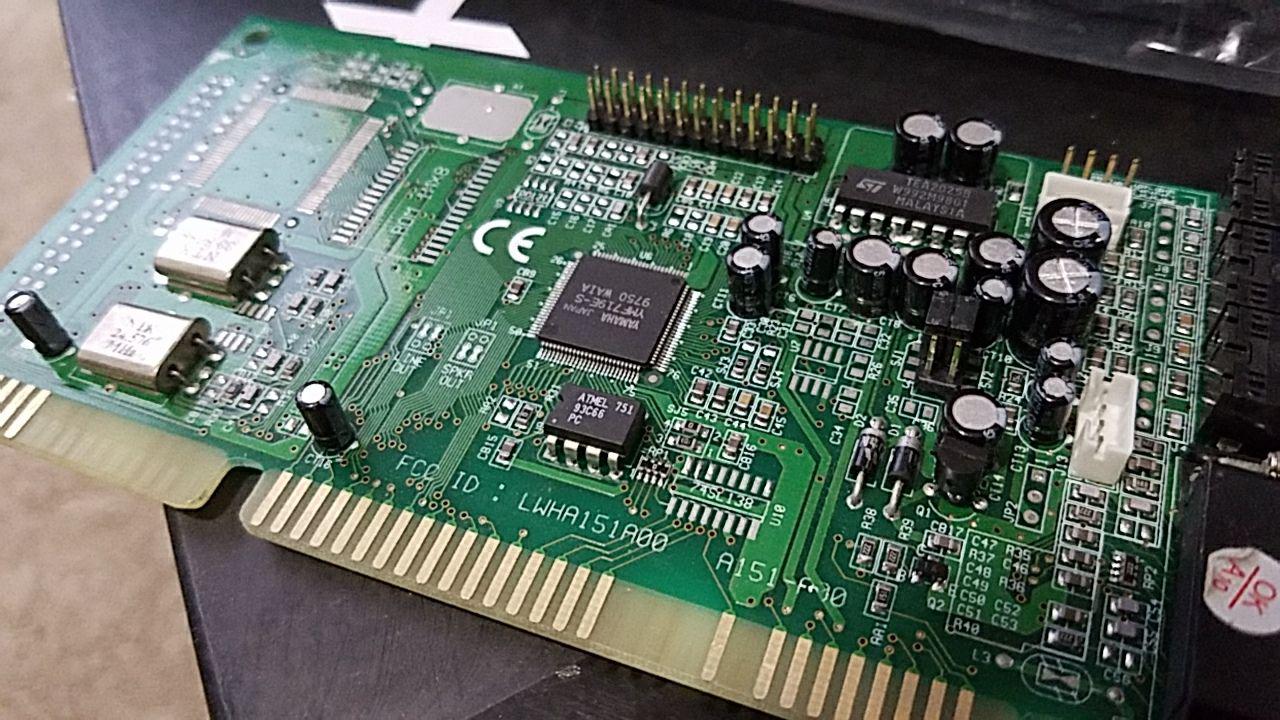
It's really unfortunate that this card did not perform properly in either board. The Audician 32 Plus is praised up and down on the Vogons forums, and for good reason: on slower machines, it's a fantastic compatible card. On these Pentium 4 setups, however, digital audio playback skips just like the Sound Blaster Pro 2. I suspect this is caused by a DMA issue again.
It's not just this specific model, either. Anything with the OPL3-SA based chips exhibits problems in the motherboards I'm using. Another example is the ATC-6631 card. Same precise issue. Amusingly, testing the Windows Sound System in the setup utility is flawless. But that's rather useless for DOS.
To configure this card, run setupsa /s on startup in autoexec. This will load the configuration into the card and initialize IRQs and DMAs.
Video Cards
Video cards are much easier to work with on Pentium 4 boards. Most anything from the mid to late 90's that fits in the board will result in a working machine. That said, some video cards will be faster and better than others, and there are a couple caveats.
The ultimate deciding factor for performance in DOS gaming is raw clock speed until high-resolution VESA modes come into play. So, a PCI card with a faster clock than a more advanced AGP card is still probably going to do better for older stuff. Newer games that use these high resolution modes will benefit greatly by being run on cards that are optimized to support them.
I tested all these with an LCD display. Some of them might work better on a CRT display.
There is a peculiar issue with some video adapters that will cause colors to have a red tint in some video modes when used with an LCD display. I'm told that the red tint problems some onboard graphics processors have will only appear on an LCD. This would suggest that the signal is the issue, not the display. It's a, (ahem,) red flag.
Integrated 845 Chipset Graphics
I experienced the red tint issue when playing Commander Keen 1. It's okay for troubleshooting, but don't do any serious DOS gaming on it.
3dfx Voodoo Graphics (PCI)

While this is not an independent video card, I can happily say it works fine in both boards. Just watch out for a dip in video quality with the earliest cards. This video quality drop has nothing to do with the Pentium 4 or the motherboard, and everything to do with the quality of the video DACs on older Voodoo cards.
ATi 3D Rage Pro (PCI)
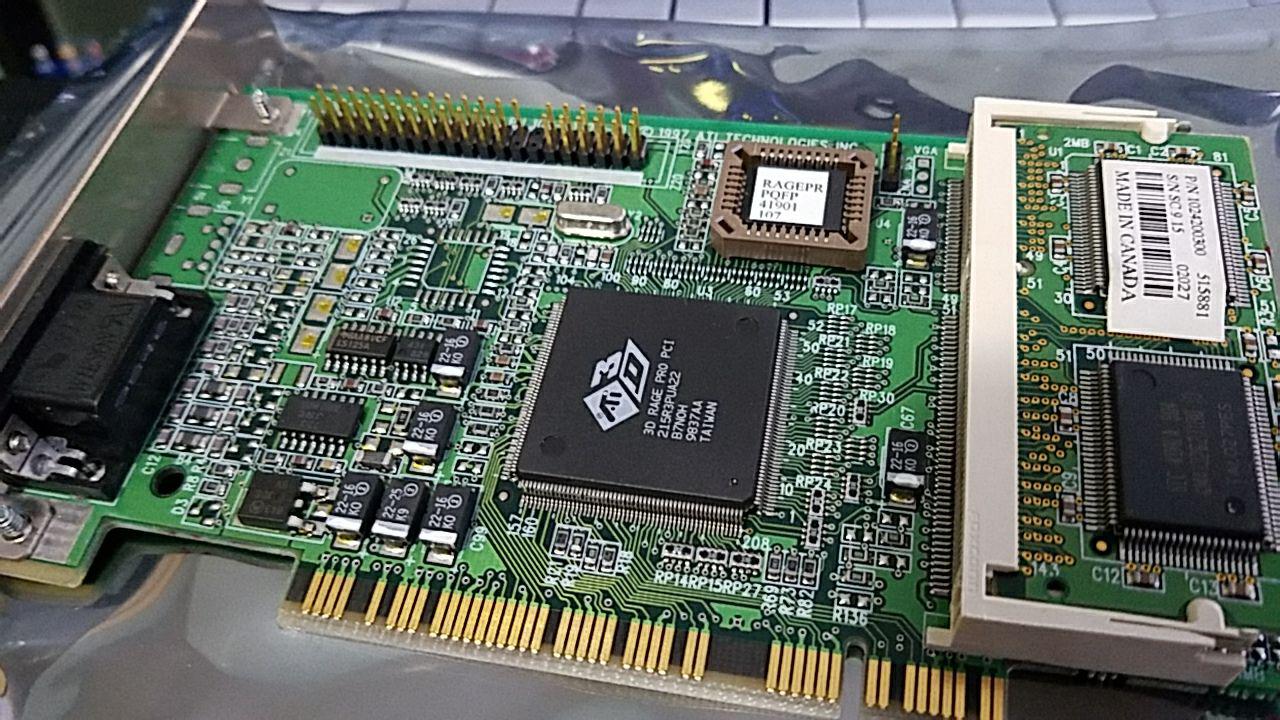
A very average performing card. I don't recommend it unless it's free. It has some scrolling problems in Commander Keen. There's nothing particularly bad about this card besides scrolling problems in some other games. But better can be had for about the same price.
Nvidia Geforce 3 Ti 500 (AGP)
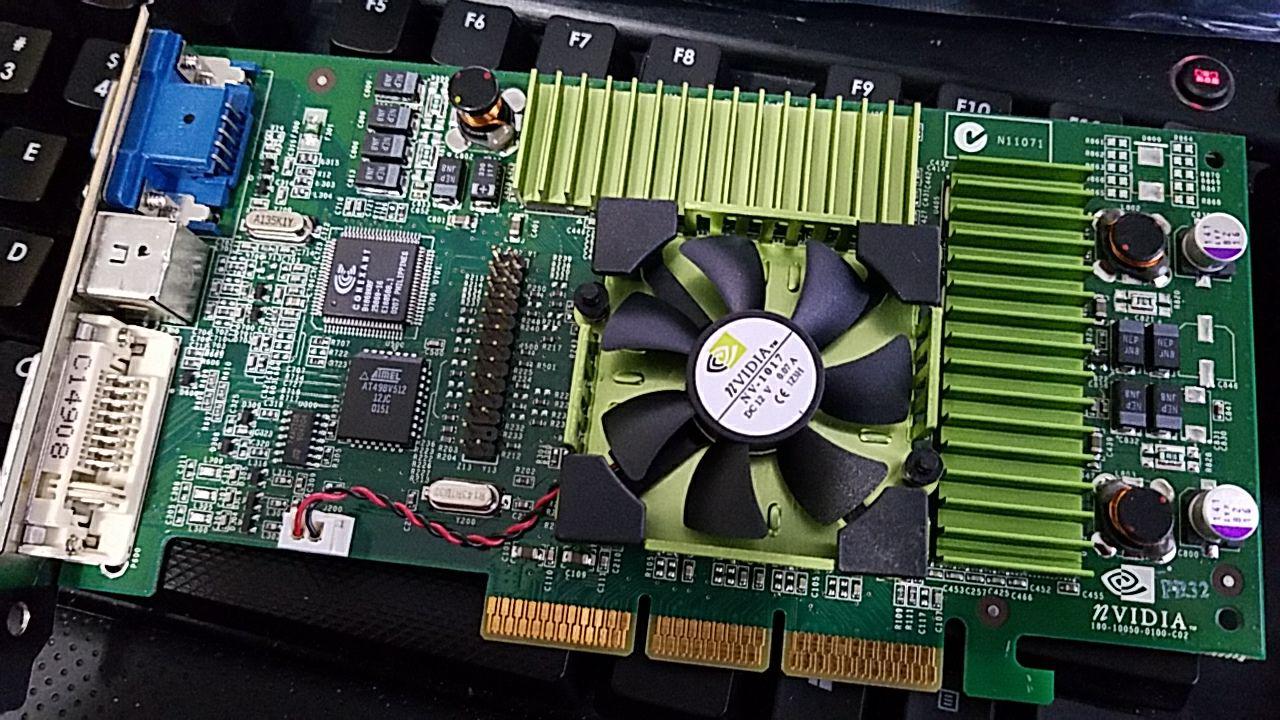
This is a pleasantly speedy card, and is reportedly the last Geforce card that was optimized for VESA video modes. However, whenever I switched to a video mode that wasn't text mode, I couldn't get anything on the screen. The resolution switches properly, but the display is just blank. Others have gotten one of these to work in their own machines, so I suspect it's just my setup.
Nvidia Geforce FX 5700 Ultra (AGP)
(No photo, it was gifted to a friend.)
This isn't a particularly fast card for DOS, but the DVI output looks great. I did not experience any video issues when using this card in pure DOS. This is a lot better suited for a Windows machine. There are no DOS games that can take advantage of the raw power offered by the 3D processor in this card.
S3 Savage 4 Pro (AGP)
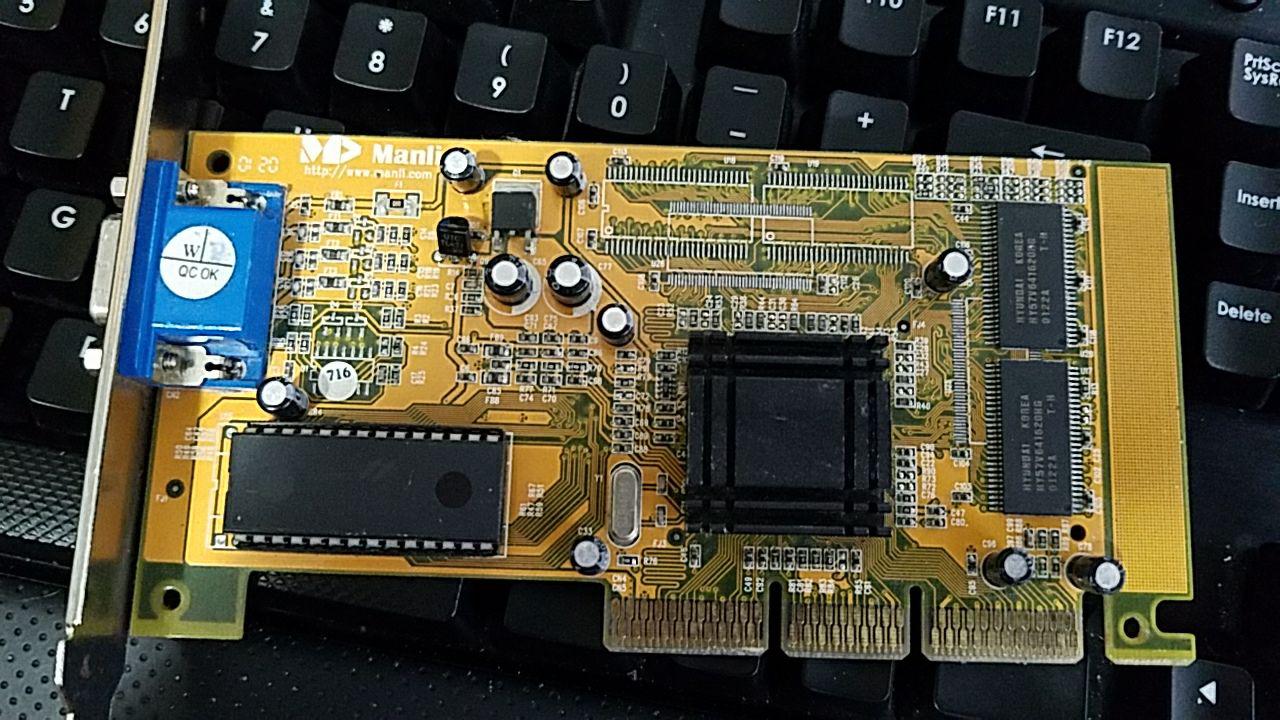
This is probably my favorite AGP video card for DOS gaming. Fast, compatible, excellent picture quality. It's often difficult to find Pro or Extreme models online easily or very cheap. PCI versions of the Savage 4 exist, but they are harder to source and don't perform any better than their AGP counterparts.
However, S3 cards are notoriously terrible at 3D acceleration in Windows. There are better options for a hybrid DOS/Win9X gaming setup.
S3 Trio64V2/DX (PCI)

This is probably my favorite PCI video card. Lightning fast in both boards, immediately compatible, great picture quality, and can be found for cheap. I would definitely recommend this if an AGP card either can't be sourced or the board doesn't have AGP.
I found that the Video BIOS inside this card is 44k instead of 48k, so I squeezed that extra 4k out as additional upper memory.
S3 Virge GX 2MB (PCI)
This is a really zippy PCI video card, much like the other S3 entries on this list. Also much like the other offerings from S3, extremely compatible.
Benchmarks
This will soon be a list of benchmarks collected from various games at various resolutions in a particular setup.
The constants:
- Pentium 4 @ 2.8gHz, 400 mHz FSB
- L1, L2 cache enabled
- PlatiniX 7LI/C-AL motherboard
- Onboard audio, LAN & GPU disabled
- Voodoo Graphics 1 8MB
- Will be inserted only for 3DFX modes
Many of these benchmarks have not been started. As such, the list of resolutions might be whittled down to whatever is possibly supported by the engine. For now, I'm using placeholders.
Games that have a specific version for a specific GPU will be tested for that GPU as well as in pure software mode, where applicable. (Voodoo cards do not operate unless their 3D acceleration is enabled.)
Quake
Quake from Id Software was a creative and technological marvel back when it was released. Getting high framerates out of this game with higher resolutions is no easy task. This game does not take advantage of 3D hardware acceleration in DOS.
Coming soon...
| GPU | 320x200 | 320x240 | 640x480 | 800x600 | 1024x768 | 1280x1024 |
|---|
Duke Nukem 3D
Duke Nukem 3D from 3D Realms is a particularly demanding game at high resolutions, running on the Build engine. This game does not take advantage of 3D hardware acceleration in DOS.
In order to get resolutions higher than 800x600, the DUKE3D.CFG file needs to be modified manually. The setup program does not allow choosing these higher resolutions, but they do work.
Coming soon...
| GPU | 320x200 | 320x240 | 640x480 | 800x600 | 1024x768 | 1280x1024 |
|---|
Descent
Descent from Parallax Software is a shining example of the Six Degrees of Freedom genre, and likely what popularized it to begin with. A patch exists to add hardware acceleration for Voodoo Graphics cards.
Coming soon...
| GPU | 320x200 | 320x240 | 640x480 | 800x600 | 1024x768 | 1280x1024 |
|---|
Descent II
Descent II from Parallax Software builds on the success of the first game and is more computationally demanding on both the CPU and GPU side. Patches exist to add hardware acceleration for Voodoo Graphics and Rendition cards.
Coming soon...
| GPU | 320x200 | 320x240 | 640x480 | 800x600 | 1024x768 | 1280x1024 |
|---|
Conclusion
Finding hardware that will work for pure DOS is really hard. The information online is rather scarce because people aren't building Pentium 4 boxes for DOS gaming. They're building Pentium II/III or K6(II/III) machines. Pentium 4 machines can be slowed significantly by disabling cache, but still don't offer as fine of speed controls. It's not a particularly attractive venture at all unless it'll primarily be used for playing games from the early to mid 90's.
For games that take advantage of extra CPU power such as high resolution Build engine games or turn based games like Master of Magic where turns take forever on a slow box (my main reason for doing this) it's a fun project.
Attractive DOS machines before the Pentium 4 era will become increasingly expensive to build in the coming years. It's only a matter of time before newcomers to the hobby will be turned away due to the massive financial barrier to entry.